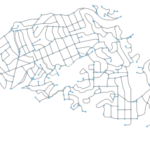OSMnx v2.0.0 is targeted for release later in 2024. This major release includes some breaking changes (including removing previously deprecated functionality) that are not backwards compatible with v1. See the migration guide and reference paper for details.
The first beta pre-release is out now, and testers are needed. If you use OSMnx, you can help test it by installing the latest pre-release. Create a virtual environment then run: pip install --pre osmnx
For more, check out the migration guide and reference paper.
 This is a guide for absolute beginners to get started using Python. Since releasing
This is a guide for absolute beginners to get started using Python. Since releasing